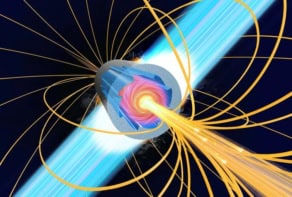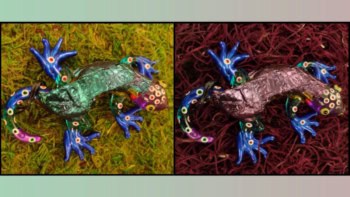
Principles of supersymmetry have been used to boost the performance of an array of solid-state lasers. The work was led by Mercedeh Khajavikhan at the University of Central Florida in the US. Her team used ideas underpinning the speculative supersymmetry theory of particle physics to suppress unwanted high-frequency modes in their array. The result was a focussed beam intensity that is more than four times greater than achieved by conventional laser arrays.
Increasing the power of a laser beam normally requires increasing the cross-sectional area of the laser cavity. This is a problem because wider cavities can support multiple transverse modes, which can create turbulence that degrades beam quality.
High-frequency supermodes
To avoid this problem, narrow solid-state laser cavities can be placed in a parallel array. If the cavities are close to one another, the modes in each cavity can couple together through evanescent electric fields that “leak” between cavities. In theory, this allows all the cavities to oscillate in step, meaning the power can be scaled up without the instabilities associated with a wider laser cavity. The problem is that such arrays can support several high-frequency “supermodes”, which degrade the laser light and make it difficult to focus the beam to a small spot.
At first glance, supersymmetry has little to do with solid-state lasers. It was first proposed in the late 1970s and it attempts to resolve long-standing problems with the Standard Model of particle physics. These include the “hierarchy problem”, which is our lack of understanding of why the weak force is much, much stronger than gravity. Supersymmetry attempts to resolve these problems by introducing a high-energy “superpartner” for every known particle.
Khajavikhan colleagues at Central Florida realized that ideas from supersymmetry could be borrowed to make better lasers. The supermodes that plague cavity arrays could be suppressed, they reasoned, if every mode except the fundamental mode was evanescently coupled to a high-energy “super-supermode”. These super-supermodes would be designed to have low quality factors and thus high losses, which would prevent the supermodes from reaching the lasing threshold. The laser could then produce a much higher energy laser beam than a standard laser array while still emitting light only at the fundamental frequency.
Creativity and ingenuity
Now, after what Khajavikhan describes as “a lot of creativity and ingenuity from our postdoc Mohammad Hokmabadi to implement and validate these abstract ideas”, the Central Florida researchers have built a supersymmetric laser array.
It comprises nine evanescently coupled quantum-well cavities etched onto a wafer. Five quantum wells form the laser itself and the other four play the role of lossy superpartners. The researchers compared the device’s far-field light output to the output of a laser containing just one quantum well and to that of a standard laser array containing five active cavities but no superpartner. The single quantum well laser produced a beam with a spread of around 24º and relatively low output power. The standard laser array produced 10 times the output power as the single quantum well laser for the same pump intensity. However, supermodes caused the beam to degrade in quality, broadening to 38° spread.
The supersymmetric laser, however, emitted almost as much power as the standard laser array, but did so in just the fundamental mode, producing a beam waist of just 11.6°. This produced an intensity at the focus 4.2 times as high as with the standard laser array. “We foresee many applications of supersymmetric laser arrays in medicine, military, industry and communications,” says Khajavikhan: “Wherever there is a need for high power integrated laser arrays having a high beam quality.”

Chaotic cavity boosts stability of high-power laser
Ortwin Hess at Imperial College, who last year helped design a laser that took completely the opposite approach and suppressed turbulence by maximizing the number of modes in a broad area laser, is impressed with the work of Christodoulides and colleagues: “I think their method is very nice,” he says. Hess adds that he is very pleased that researchers have succeeded in taking two different approaches to solving the same problem.
Optical physicist Lan Yang of Washington University of St Louis in Missouri, US agrees: “The marriage of theory and experiment is quite novel. This is a wonderful, collaborative work,” she says.” She says that more work is now needed to check the stability of the laser’s intensity: “If they can find a strategy to manipulate the lasing profile, that will be even better.”
The research is described in Science.


